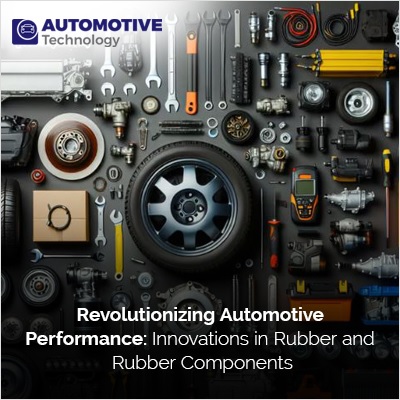Articles
Revolutionizing Automotive Performance: Innovations in Rubber and Rubber Components

Introduction
Experience the cutting-edge advancements in automotive performance with the latest innovations in rubber and rubber components. From tires to engine mounts, these new technologies are revolutionizing the way vehicles perform on the road. With a focus on durability, flexibility, and enhanced performance, manufacturers are constantly pushing the boundaries of what rubber can do. These innovations not only improve the driving experience but also contribute to increased fuel efficiency and reduced carbon emissions. From eco-friendly tire compounds to state-of-the-art vibration isolation systems, these advancements are making cars safer, more comfortable, and more sustainable. The use of advanced materials and manufacturing techniques allows for better grip, reduced noise, and improved handling, giving drivers a new level of control and confidence on the road. As technology continues to evolve, so does the automotive industry, and these advancements in rubber and rubber components are at the forefront of this progress. Embrace the future of automotive performance and discover the remarkable difference these innovations can make in your driving experience.
The Importance of Rubber in Automotive Performance
Rubber plays a crucial role in automotive performance, as it is used in various components that directly impact the driving experience. One of the key areas where rubber is indispensable is in tires. Tires are the only point of contact between the vehicle and the road, making them critical for safety, handling, and performance. The composition of the rubber compound used in tires determines its grip, durability, and resistance to wear. Innovations in rubber technology have allowed manufacturers to develop tires that offer superior traction, better fuel efficiency, and longer lifespan. Furthermore, rubber is used in engine mounts, suspension bushings, and other components that help dampen vibrations and reduce noise, enhancing overall driving comfort. Without the advancements in rubber and rubber components, modern vehicles wouldn't be able to achieve the level of performance and comfort that we enjoy today.
Recent Innovations in Rubber Technology
In recent years, there have been significant advancements in rubber technology that have revolutionized automotive performance. One notable innovation is the development of silica-enhanced tire compounds. Silica is mixed with rubber to create a more durable and flexible tire, resulting in better grip and improved fuel efficiency. Silica-enhanced compounds also reduce rolling resistance, which translates to lower fuel consumption and reduced carbon emissions. Another breakthrough in rubber technology is the use of nanotechnology to enhance the performance of rubber components. By incorporating nanoparticles into rubber, engineers can manipulate its properties, such as strength, elasticity, and thermal conductivity. This opens up new possibilities for improving the performance and durability of rubber components in various applications, including automotive.
Advancements in Rubber Components for Tires
Tire technology has come a long way, thanks to advancements in rubber components. One such advancement is the development of run-flat tires. Run-flat tires are designed to support the weight of the vehicle even when punctured, allowing the driver to continue driving safely for a limited distance. This eliminates the need for immediate tire replacement and provides added convenience and safety. Another innovation is the use of self-sealing tire technology. Self-sealing tires contain an inner layer of rubber that seals small punctures automatically, preventing air loss and reducing the risk of a flat tire. These advancements in rubber components for tires not only improve safety but also provide peace of mind for drivers, especially in situations where immediate tire replacement may not be feasible.
Improvements in Rubber Seals and Gaskets
Rubber seals and gaskets play a vital role in preventing fluid leaks and maintaining the integrity of various automotive systems. Recent advancements in rubber technology have led to the development of improved seals and gaskets that offer better durability, enhanced sealing properties, and resistance to extreme temperatures and chemicals. This is particularly important in critical areas such as the engine, transmission, and cooling systems, where leaks can lead to costly repairs and potential damage to the vehicle. The use of advanced rubber materials, such as fluorocarbon elastomers, has significantly improved the performance and longevity of seals and gaskets, ensuring the reliable and leak-free operation of automotive systems.
The Impact of Rubber on Vehicle Safety and Comfort
Rubber components not only contribute to the performance of a vehicle but also play a crucial role in ensuring safety and comfort for the occupants. One area where rubber has a significant impact is in vibration isolation systems. Engine mounts, suspension bushings, and other rubber components help absorb vibrations and reduce noise, providing a smoother and more comfortable ride. These components also help improve vehicle stability and handling by minimizing the transfer of vibrations to the chassis. In terms of safety, rubber is vital in the manufacturing of anti-lock braking system (ABS) components. Rubber seals and gaskets in the ABS system prevent fluid leaks and ensure the system functions properly, ultimately enhancing the safety of the vehicle and its occupants.
Sustainable and Eco-Friendly Rubber Solutions
With the growing concern for environmental sustainability, the automotive industry is actively seeking eco-friendly solutions, including in the use of rubber. One such solution is the development of eco-friendly tire compounds. These compounds are made from renewable or recycled materials, reducing the reliance on fossil fuels and minimizing the environmental impact of tire production and disposal. Additionally, tire manufacturers are working on improving the recyclability of tires by developing innovative recycling methods and exploring new uses for recycled tire rubber. By embracing sustainable and eco-friendly rubber solutions, the automotive industry is moving towards a greener future while maintaining high-performance standards.
Future Trends in Rubber and Rubber Components for Automotive Applications
The future of rubber in automotive performance holds exciting possibilities. As technology continues to advance, we can expect to see further innovations in rubber and rubber components that will enhance vehicle performance, safety, and comfort. One of the key areas of focus is the development of intelligent tires. These tires will be equipped with sensors that can monitor tire pressure, temperature, and wear in real-time, providing valuable data to drivers and vehicle systems. Another trend is the integration of rubber components with smart vehicle systems, allowing for more precise control and optimization of various functions. Furthermore, there is ongoing research into the development of self-healing rubber materials, which could potentially eliminate the need for tire repairs or replacements altogether. The future of rubber in automotive applications looks promising, with endless possibilities for improving the driving experience.
Case Studies of Successful Rubber Innovations in the Automotive Industry
Several case studies highlight the successful implementation of rubber innovations in the automotive industry. One such example is the use of advanced tire compounds in high-performance sports cars. These compounds provide exceptional grip and handling, allowing drivers to push the limits of their vehicles on the track. Another case study involves the development of noise-canceling rubber components for luxury vehicles. By incorporating special rubber materials and designs, manufacturers have been able to significantly reduce road noise, creating a quieter and more refined driving experience. These case studies demonstrate the tangible benefits that rubber innovations can bring to different types of vehicles and driving scenarios, further emphasizing the importance of ongoing research and development in this field.
Conclusion: The Future of Rubber in Automotive Performance
In conclusion, the constant advancements in rubber and rubber components are revolutionizing automotive performance in multiple ways. From improvements in tire compounds to the development of eco-friendly solutions, these innovations are enhancing the driving experience, increasing safety, and contributing to a more sustainable future. Rubber plays a crucial role in ensuring vehicle performance, comfort, and safety, and as technology continues to evolve, we can expect further breakthroughs in this field. The future of rubber in automotive performance holds immense potential, and by embracing these innovations, drivers can look forward to a new level of control, confidence, and enjoyment on the road.



